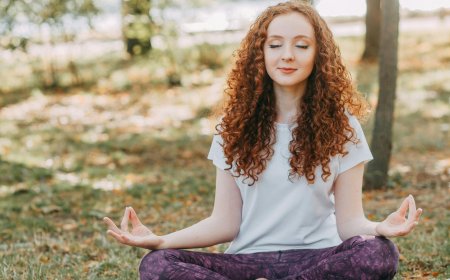"The Benefits of Incorporating Yoga into Your Daily Routine"
In the quest for a balanced and fulfilling life, many people are turning to yoga as a powerful tool to enhance both physical and mental well-being. Yoga, an ancient practice rooted in India, combines physical postures, breath control, meditation, and ethical principles to promote overall health. By incorporating yoga into your daily routine.

we'll explore the numerous advantages of integrating yoga into your daily life and provide tips on how to get started.
The Comprehensive Benefits of Yoga
1. Physical Health Improvements
Increased Flexibility: Regular yoga practice helps to lengthen and stretch the muscles, improving overall flexibility. This can lead to better posture, reduced muscle tension, and a lower risk of injury.
Enhanced Strength: Many yoga poses require you to support your body weight in various positions, which helps to build strength. Poses like plank and warrior not only strengthen core muscles but also improve overall muscle tone.
Improved Balance and Coordination: Yoga improves balance by engaging stabilizing muscles and enhancing body awareness. This can be particularly beneficial as you age, helping to prevent falls and maintain functional movement.
Better Posture: Yoga encourages proper alignment and body awareness, which can help alleviate common issues related to poor posture, such as back pain and neck stiffness.
Increased Circulation and Heart Health: Yoga promotes better circulation by encouraging deep breathing and relaxation. This can contribute to improved cardiovascular health and reduced blood pressure.
2. Mental and Emotional Well-being
Stress Reduction: Yoga incorporates relaxation techniques and mindfulness, which help to reduce stress and anxiety. Practicing yoga regularly can activate the parasympathetic nervous system, leading to a state of calm and relaxation.
Enhanced Mood: The practice of yoga stimulates the production of endorphins, the body’s natural mood lifters. This can lead to improved mood and overall emotional well-being.
Better Sleep: By reducing stress and promoting relaxation, yoga can improve sleep quality. Practices such as gentle stretches and meditation before bed can help calm the mind and prepare the body for restful sleep.
Increased Mindfulness and Focus: Yoga encourages mindfulness and present-moment awareness. This can help improve concentration, cognitive function, and the ability to manage daily challenges more effectively.
3. Holistic Health Benefits
Improved Digestion: Certain yoga poses, such as twists and inversions, can aid digestion by stimulating the digestive organs and improving circulation to the abdominal area.
Enhanced Respiratory Function: Yoga emphasizes deep breathing techniques that improve lung capacity and respiratory function. This can be especially beneficial for those with respiratory conditions or for increasing overall vitality.
Emotional Resilience: Through meditation and mindfulness, yoga helps develop emotional resilience, allowing you to navigate life’s challenges with greater ease and composure.
Community and Connection: Joining a yoga class or community can provide a sense of belonging and support, enhancing your social well-being and fostering meaningful connections.
How to Incorporate Yoga into Your Daily Routine
1. Start Small: If you're new to yoga, begin with short, manageable sessions. Even a 10-15 minute practice can be beneficial. Gradually increase the duration as you become more comfortable.
2. Find a Style That Suits You: Yoga comes in many styles, from the gentle and restorative to the more vigorous and dynamic. Explore different styles like Hatha, Vinyasa, or Yin to find what resonates with you.
3. Create a Consistent Schedule: Set aside a specific time each day for your yoga practice. Consistency is key to reaping the benefits, so try to make yoga a regular part of your daily routine.
4. Use Online Resources: There are countless online classes, apps, and videos available for practicing yoga at home. Find a reputable source or instructor that suits your needs and preferences.
5. Incorporate Yoga into Daily Activities: You don’t always need a dedicated practice session. Incorporate yoga stretches and mindful breathing into your daily activities, such as during breaks at work or before bed.
6. Listen to Your Body: Yoga is about tuning into your body’s needs and limitations. Avoid pushing yourself too hard and honor where you are in your practice.
7. Set Realistic Goals: Set achievable goals for your yoga practice, whether it's improving flexibility, managing stress, or simply feeling more connected to your body. Celebrate your progress along the way.
Yoga Poses to Get You Started
1. Child’s Pose (Balasana): A restorative pose that gently stretches the back, hips, and thighs. Great for relaxation and calming the mind.
2. Downward-Facing Dog (Adho Mukha Svanasana): A full-body stretch that strengthens the arms, legs, and core while improving circulation.
3. Warrior II (Virabhadrasana II): A standing pose that builds strength in the legs, core, and arms while enhancing balance and stability.
4. Cat-Cow Pose (Marjaryasana-Bitilasana): A gentle flow between two poses that warms up the spine and improves flexibility.
5. Bridge Pose (Setu Bandhasana): A pose that strengthens the back, glutes, and core while opening the chest and improving posture.
Conclusion
Incorporating yoga into your daily routine offers a wealth of benefits for both body and mind. From improved physical health and mental clarity to enhanced emotional resilience and overall well-being, the practice of yoga can be a transformative addition to your life. By starting with small, manageable steps and integrating yoga into your daily routine.
What's Your Reaction?


















































































